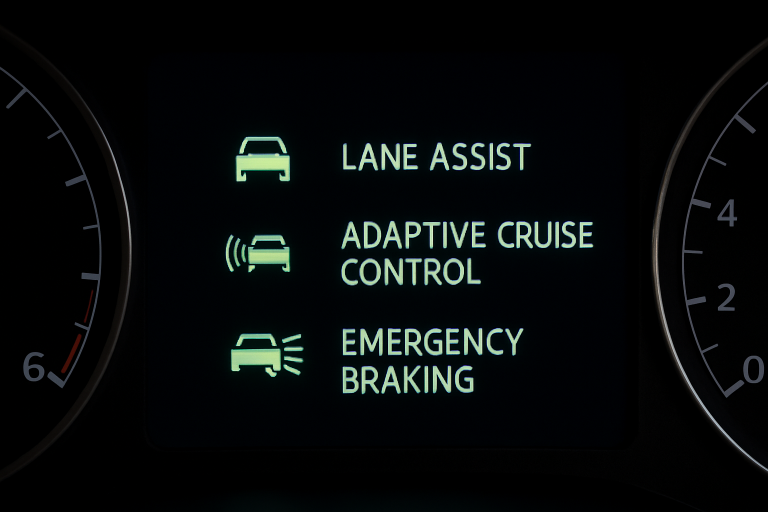Key Takeaways
- Modern vehicles now have technologies that substantially reduce accident risks and increase driver convenience.
- Features such as Advanced Driver-Assistance Systems (ADAS) and Vehicle-to-Everything (V2X) communication are prevalent among new models.
- Understanding these features helps buyers make wise choices, supporting safer roads for all.
Table of Contents
- Introduction
- Advanced Driver-Assistance Systems (ADAS)
- Vehicle-to-Everything (V2X) Communication
- Blind Spot Detection
- Automatic Emergency Braking (AEB)
- Electronic Stability Control (ESC)
- Adaptive Cruise Control (ACC)
- Lane Departure Warning (LDW) and Lane Keeping Assist (LKA)
- Final Thoughts
Introduction
In recent years, innovation in the automotive industry has transformed how we think about safety and convenience behind the wheel. Modern vehicles now feature a range of advanced systems to minimize risks and make the driving experience smoother and more enjoyable. For those exploring the newest innovations, you can learn more about these cutting-edge advancements available in today’s vehicles, which are standard across numerous makes and models.
From automated emergency braking to sophisticated driver-assistance networks, these technologies are not just add-ons but integral components ensuring safer and smarter travel for drivers and passengers. Automakers continue to push the envelope on what’s possible, offering solutions for everything from traffic congestion to fatigue reduction, fundamentally changing our relationship with our cars.
Advanced Driver-Assistance Systems (ADAS)
ADAS refers to a comprehensive collection of technologies that deploy sensors, cameras, and radar to help drivers safely navigate roadways. These systems constantly monitor a vehicle’s environment and offer immediate feedback or, in critical cases, direct intervention. Prominent ADAS features include:
- Adaptive Cruise Control (ACC): Maintains a preset distance from the vehicle ahead by automatically speeding up or slowing down.
- Lane Keeping Assist (LKA): Uses visual lane markers to gently steer the vehicle back into the correct lane if drifting is detected.
- Automatic Emergency Brakes (AEB) detect obstacles and apply the brakes when a collision is imminent, reducing or preventing impact.
These technologies lessen collision risks, reduce driver fatigue, and make long journeys safer and more comfortable.

Vehicle-to-Everything (V2X) Communication
V2X communication turns vehicles into networked hubs, linked with infrastructure like road signs, traffic lights, and other cars. This two-way data exchange means drivers can get real-time information about traffic jams, roadwork, or dangerous conditions ahead, improving situational awareness and enabling better decision-making on the road. According to experts, V2X also holds great promise for the rollout of autonomous vehicles in the coming years.
Blind Spot Detection
Since its introduction by Volvo in 2004, blind spot detection has become a staple of modern vehicle safety systems. Sensors or cameras positioned along the car’s flanks alert drivers to vehicles in their blind spots through illuminated icons or audible alerts. More advanced models add safeguards such as loud beeps or steering wheel vibrations if a turn signal is engaged. At the same time, a vehicle occupies the blind spot, and in some cases, automatic steering intervention can prevent unsafe lane changes. Blind spot detection lowered lane-change crash rates by nearly 14%, according to IIHS research.
Automatic Emergency Braking (AEB)
AEB has emerged as one of the most effective collision-avoidance technologies. Systems use advanced sensors to detect an imminent collision, and if the driver fails to react, the brakes automatically engage to stop or significantly slow the vehicle. This technology is not limited to forward motion; some cars can also perform emergency braking in reverse or pedestrian-detection scenarios. According to Consumer Reports, automakers have committed to standardizing AEB, reflecting its life-saving benefits.
Electronic Stability Control (ESC)
ESC is a computerized safety feature designed to keep drivers in control, especially during slippery or emergency maneuvers. This system detects skids and automatically applies the brakes to individual wheels, aiding in regaining directional control. ESC can also limit engine power to restore stability. While ESC doesn’t allow vehicles to turn more sharply or corner faster, it significantly improves the chance of keeping the car on its intended path, preventing a third of all fatal traffic accidents, according to the NHTSA.
Adaptive Cruise Control (ACC)
This technology is a favorite among highway travelers. Adaptive cruise control automatically adjusts vehicle speed based on the traffic ahead, keeping a safe following distance without constant manual input. This reduces stress and fatigue on long trips and helps prevent rear-end collisions in stop-and-go traffic.
Lane Departure Warning (LDW) and Lane Keeping Assist (LKA)
LDW and LKA keep drivers from unintentionally veering into adjacent lanes. LDW issues audible, visual, or tactile warnings, while LKA can even steer or brake to keep the vehicle centered. Though studies on the long-term effectiveness of these features are ongoing, they represent a promising step toward fewer sideswipe and run-off-road accidents.
Final Thoughts
The technology incorporated into today’s vehicles is actively reshaping the driving and riding experience. As car buyers become more educated on these innovative features, they not only benefit from increased comfort and convenience but also contribute to the creation of safer roadways everywhere. The journey toward smarter, safer vehicles continues, with each advancement marking a significant step forward for driver and passenger well-being.
Leave a Reply